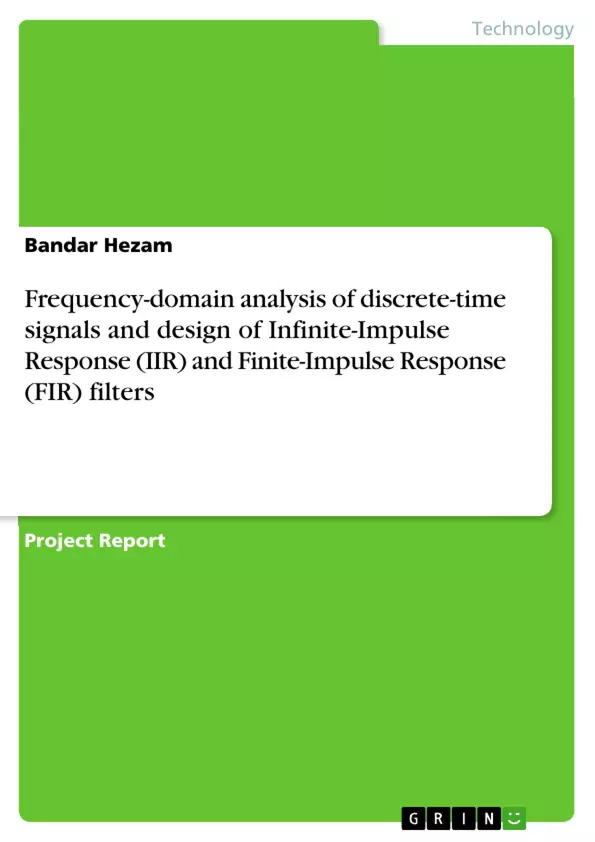The main objectives of this lab report is to generate frequency-domain analysis of discrete-time signals and to design appropriate Infinite-Impulse Response (IIR) and Finite-Impulse Response (FIR) filters.
Digital filters provide an important role in the world of communication. This lab report will discuss the steps taken to develop and design IIR and FIR filters of two filters types which are the Low-pass and the Band-pass filters. The main objective of this lab report to compare and analyze the IIR and FIR filters. At first, a background about the topic of the report would be made. Then, the theoretical concept of the filters is being discussed. After that, the procedure and the steps taken to design the filters are to be explained. Then, the results would be displayed and analyzed. A discussion about the observations and findings made are to be stated. At last, a conclusion about the achievements made and the major outcomes of the investigation are stated.
Inhaltsverzeichnis (Table of Contents)
- Acknowledgment
- Abstract
- Objective
- Table of Figures
- 1 Introduction
- 2 Theoretical Concepts
- 2.1 Finite Impulse Response - FIR
- 2.2 Infinite Impulse Response – IIR
- 3 Procedure
- 4 Analysis
- 5 Discussion
- 6 Conclusion
- 7 References
Zielsetzung und Themenschwerpunkte (Objectives and Key Themes)
This lab report investigates the design and analysis of IIR and FIR filters, specifically low-pass and band-pass filters. The report aims to compare and analyze the performance of these filter types in the context of digital signal processing.
- Frequency-domain analysis of discrete-time signals
- Design and implementation of IIR and FIR filters
- Comparison of IIR and FIR filter performance
- Application of filtering techniques in digital signal processing
- Evaluation of filter characteristics and their impact on signal processing
Zusammenfassung der Kapitel (Chapter Summaries)
- Introduction: This chapter provides an overview of digital signal processing (DSP) and its applications, particularly in the field of filtering. It highlights the importance of digital filters in communication systems and introduces the two main types: FIR and IIR filters. The chapter also outlines the purpose of the lab report, which is to design and compare low-pass and band-pass filters using both IIR and FIR techniques.
- Theoretical Concepts: This chapter delves into the theoretical foundations of FIR and IIR filters. It explains the principles behind these filter types, including their impulse responses, frequency characteristics, and design methods. This section lays the groundwork for understanding the practical aspects of filter design and analysis covered in subsequent chapters.
- Procedure: This chapter outlines the step-by-step process followed to design and implement the IIR and FIR filters. It details the specific software and techniques used, including the selection of filter parameters, the implementation of the filter equations, and the analysis of the resulting filter response.
- Analysis: This chapter presents the results of the filter design and analysis. It includes visualizations of the filter responses, frequency-domain analysis, and a comparison of the performance metrics of IIR and FIR filters. This section provides empirical evidence to support the theoretical concepts presented earlier.
Schlüsselwörter (Keywords)
The key terms and focus areas of this lab report include digital signal processing, frequency-domain analysis, IIR and FIR filters, low-pass filter, band-pass filter, filter design, filter implementation, filter characteristics, and signal processing applications.
- Arbeit zitieren
- Bandar Hezam (Autor:in), Frequency-domain analysis of discrete-time signals and design of Infinite-Impulse Response (IIR) and Finite-Impulse Response (FIR) filters, München, GRIN Verlag, https://www.hausarbeiten.de/document/1321034


